Revisiting the “Cultural Revolution” in Tibet
[Source: tibet.net]
The ten-year-long Cultural Revolution is generally considered to have begun in China in 1966, when the Politburo of the Communist Party of China adopted Mao Zedong’s so-called May 16th Notice.[1] In Tibet, however, the climate of Cultural Revolution existed since 1959, when the People’s Republic of China completely occupied Tibet and carried out a series of repressive and violent campaigns, which included democratic reform, fomenting class struggle and imposing a commune system. According to the 10th Panchen Lama’s famous 70,000-character petition written in 1962 and submitted to the Chinese government on the conditions inside Tibet, “more than 97 percent of monasteries and nunneries were destroyed and the number of monks and nuns living in the monasteries was reduced by 93 percent.”[2] Tibetan language, dress, customs and habits were considered backward, filthy, useless and favoring old society, and anyone who defied the authorities were subjected to thamzing (public “struggle sessions”). Months before the actual start of the Cultural Revolution in February 1966, the Chinese authorities banned the celebration of the Monlam ceremony in Lhasa by ridiculing it as a waste of resources.[3] The banning of the Monlam ceremony meant that from now on religious devotion could not be publicly expressed and anyone who did so was seen as favoring the old society[4] and were subjected to a “struggle session.”
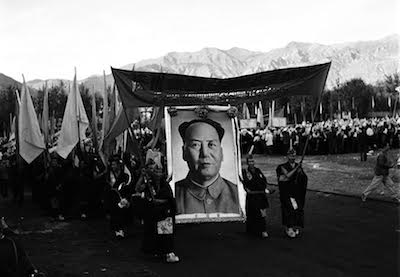
Two monks with a banner lead a group of monks with a giant portrait of Mao Zedong and flags to celebrate the foundation of the so-called “Tibet Autonomous Region” on September 9, 1965. Less than a year later, the monks and nuns became the target of the wrath of violent Red Guards during the Cultural Revolution.
During the ten-year-long Cultural Revolution in Tibet from 1966 to 1976,[5] the attack on Tibetan religion, culture, identity and traditional way of life was further intensified. Mani walls, prayer flags, incense burning, circumambulation and prostration were all banned, and monks and nuns were forced to marry or sent to labor camps. Religious texts and books were labeled as “poisonous weeds” and burned, thrown in the river or mixed with dung. The only book with authorized circulation at that time was the Little Red Book[6] containing quotations from Chairman Mao. The number of Moa’s little red books in a home exceed the number of family members. If someone won an award, they would receive the Little Red Book instead of the usual prize or certificate. Men and women were given little red books as wedding gifts. When students graduated from school, they were presented with the Little Red Book. Friends exchange the Little Red Book as a keepsake when they parted.[7]

The Jokhang Temple was decimated under the slogan, “smash the four olds” by the Red Guards of Lhasa. The destroyed statues, artefacts and other religious objects piled up in the courtyard are said to have been ransacked from the main chapel and thrown down.
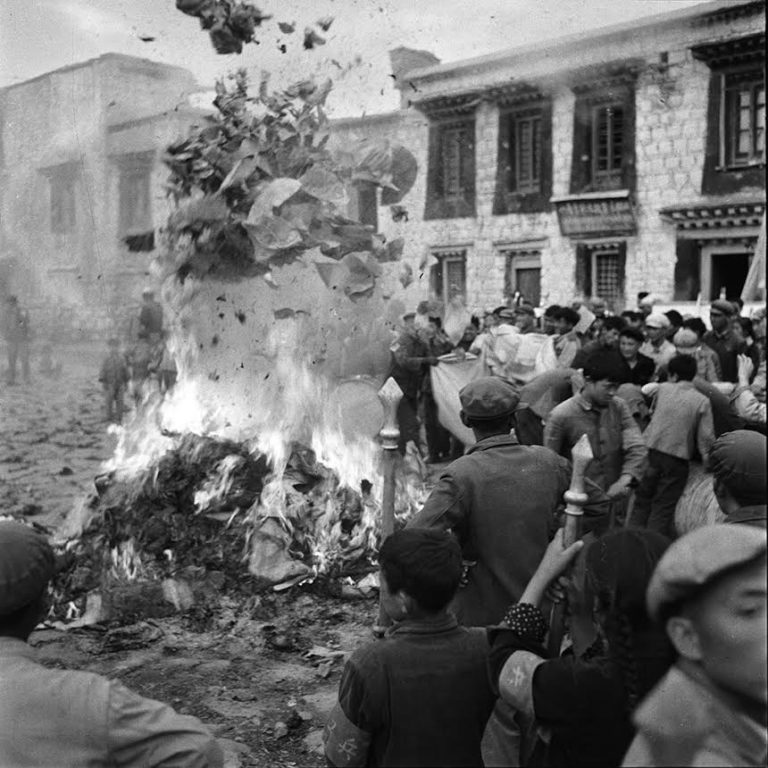
Numerous religious scriptures and religious texts are engulfed in flame near Jokhang Temple, Lhasa. These scriptures are sacred Buddhist texts and commentaries that were once part of the sacred and priceless literature collection of the monasteries of Tibet.
Most of the schools were shut down and Tibetan and Chinese students formed Red Guard brigades and attacked the “four olds” – old thoughts, old customs, old habits and old cultures. The Jokhang temple, Tibetan Buddhists’ most sacred site, was plundered, destroyed and desecrated beyond repair, as the communists believed that the temple embodied the “four olds.” Teachers and academics were defiled as “intellectuals” and subjected to “struggle sessions.” Names of streets, roads, shops, villages and even personal names were rewritten in Chinese.
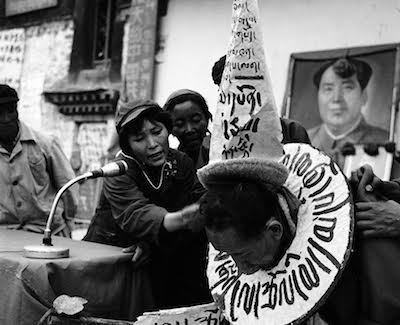
Tsadi Tseten Dorjee is subjected to a fierce “struggle session” by Lugug Achak, the lady wearing a military cap, inside the Jokhang Temple courtyard. Lugug Achak, prior to 1959, was a beggar, commonly known by the name, Lugug Tangpo (beggar). The long placard on Tsadi Tseten Dorjee’s chest reads: “Murderer of the proletariat, key conspirator of the uprising and counter-revolutionary fugitive.”
Although the Cultural Revolution in China was unleashed by Mao to eliminate his enemies and reshape relations within the party,[8] in Tibet, the Cultural Revolution was aimed to destroy Tibet’s religion, culture and identity. When it ended with Mao’s death in September 1976, more than 6,000 monasteries and religious institutions in Tibet laid in ruins. Millions of ancient and priceless manuscripts were burnt. Statues made of gold, silver, or bronze were removed from the temples and shipped to China.[9] The physical torture and psychological traumas endured by Tibetans during public “struggle sessions” and imprisonment were beyond human comprehension. At least 92,000 Tibetans who were subjected to “struggle sessions” died or committed suicide[10] and around 173,000 Tibetans died in prison, or in “Reform Through Labor Camps” (Laogai).[11]
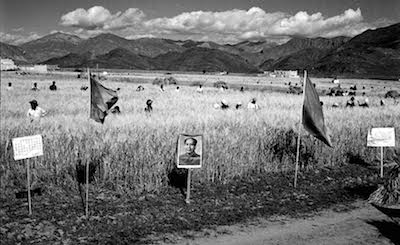
Portrait of Mao Zedong and Chinese communist propaganda placards and banners around the agricultural lands of a village in Tibet. Mao’s portrait and communist flags adorning villages were a common sight during the Cultural Revolution.
Even forty years after the end of the Cultural Revolution, the attack on Tibetan religion, culture, language and way of life continues. The remnants of the Cultural Revolution are present even today in the form of various policies and campaigns launched one after another by the Chinese government.
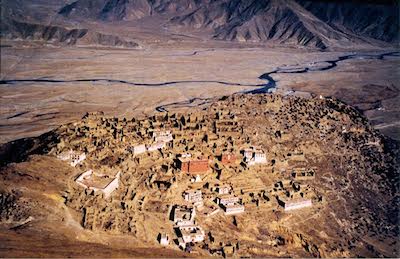
Ganden Monastery, one of the largest monasteries in Tibet, was home to more than 5000 monks before 1959. It was destroyed during the Cultural Revolution and now houses only around 500 monks.
Through campaigns such as “Strike Hard”[12] and “Patriotic Re-education”[13] the government maintains a chokehold on religious institutions; requiring recognition of all reincarnate tulkus or lamas to be apprised by Beijing,[14] and forcing Tibetans to denounce His Holiness the Dalai Lama. Even today, decades after the Cultural Revolution, Beijing’s hardline policies have led to executions, destruction of religious institutions, political indoctrination, expulsion of monks and nuns, imprisonment, banning of religious ceremonies, restricting the number of monks in monasteries and enforcing loyalty to the party.
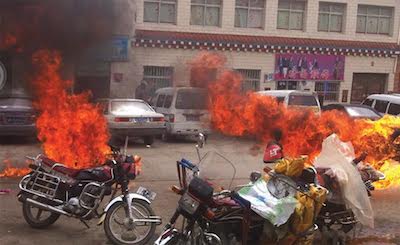
Ngawang Norphel and Tenzin Khedup setting themselves alight in Zatoe, Yushul,
Amdo Province, 20 June 2012, Photo courtesy: AP
China’s continued repression in Tibet and its persistent hardline policies including political repression, economic marginalization, social discrimination, cultural assimilation and environmental destruction have led to a new wave of peaceful protest by Tibetans in the form of self-immolation. From February 2009 until March 2016, 144 Tibetans have self-immolated protesting China’s rule. Of this number, 125 have died, while the whereabouts and conditions of those who survived remain unknown.[15] Although the Cultural Revolution is said to have ended forty years ago, China’s continuing hardline policies in Tibet are evidence of its attempt to erase Tibet’s past, present and future.
[1] Melvyn C. Goldstein, Ben Jiao and Tanzen Lhundrup, On the Cultural Revolution in Tibet – The Nyemo Incident of 1969, p. 11.
[2] Panchen Lama, 70,000 Character Petition (Tib. Language), p. 75.
[3] Tsering Shakya, The Dragon in the Land of Snows – A History of Modern Tibet since 1947, p. 317.
[4] Ibid
[5] Cultural Revolution in Tibet, http://factsanddetails.com/china/cat6/sub32/entry-4425.html
[6] Quotations from Chairman Mao Tse-tung, https://en.wikipedia.org/wiki/Quotations_from_Chairman_Mao_Tse-tung
[7] Pema Bhum, Six Stars with the Crooked Neck, p. 90.
[8] Melvyn C. Goldstein, Ben Jiao and Tanzen Lhundrup,
On the Cultural Revolution in Tibet-The Nyemo Incident of 1969, p. 11
[9] Thomas Laird, The Story of Tibet – Conversation with the Dalai Lama, p. 346.
[10] Thomas Laird, The Story of Tibet – Conversation with the Dalai Lama, p. 347.
[11] Thomas Laird, The Story of Tibet – Conversation with the Dalai Lama, p. 348.
[12] China launches “Strike Hard” Campaign ahead of sensitive
anniversary, http://tchrd.org/china-launches-strike-hard-campaign-ahead-of-sensitive-anniversary-2/
[13] The “Patriotic Education” of Tibet, http://thediplomat.com/ 2013/08/the-patriotic-education-of-tibet/
[14] New measures on reincarnation reveal Party’s objectives of political control, https://www.savetibet.org/new-measures-on -reincarnation-reveal-partys-objectives-of-political-control/
[15] Fact Sheet on Tibetan Self-Immolation Protests in Tibet Since February 2009, http://tibet.net/situation-in-tibet/factsheet-immolation-2011-2012/
